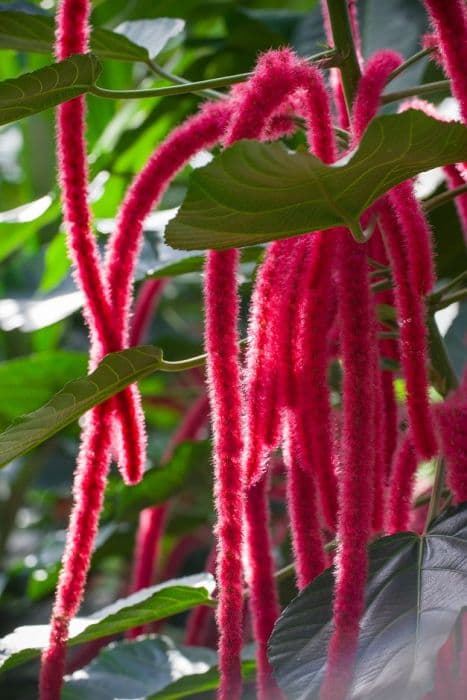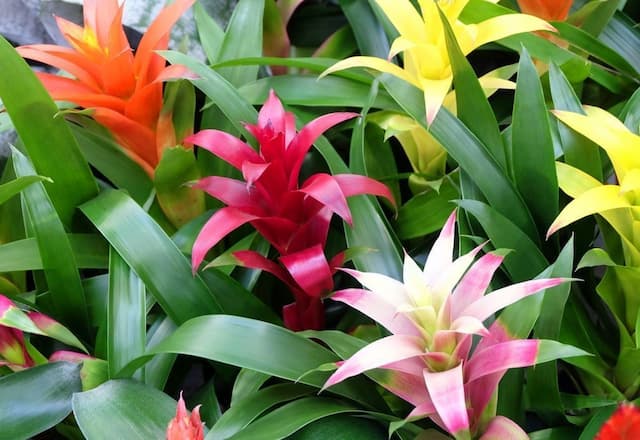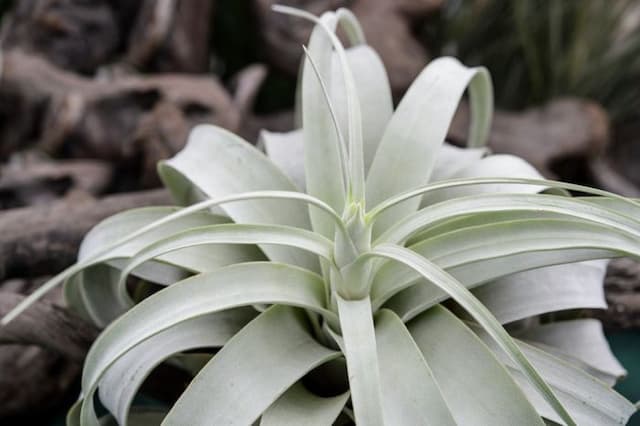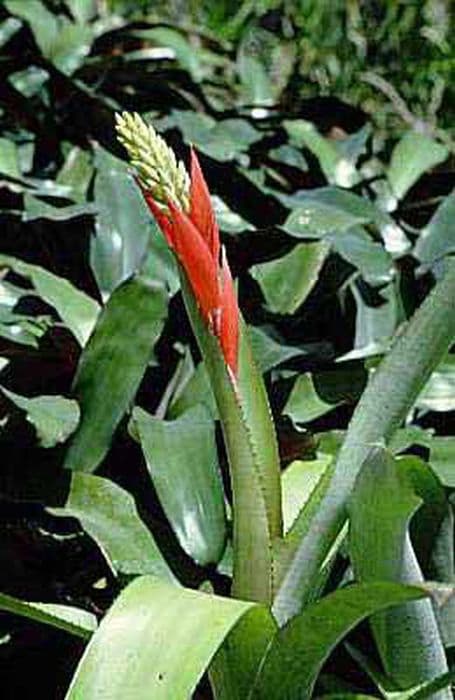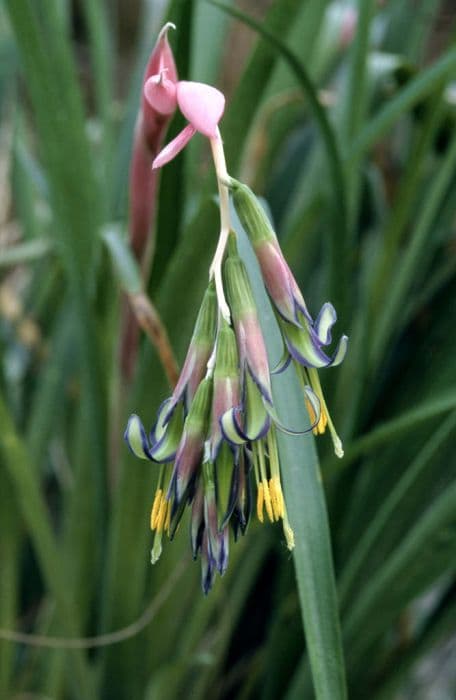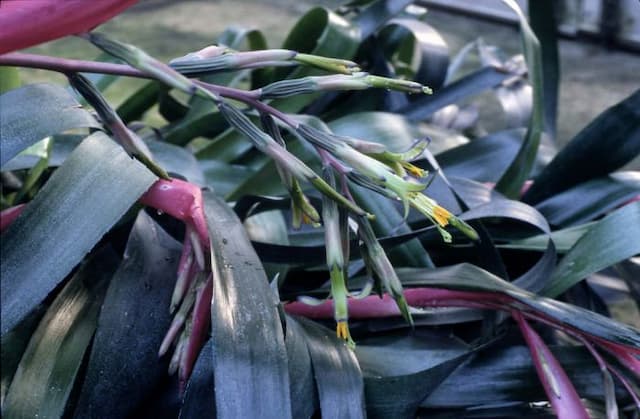Racina's Aechmea Aechmea racinae

ABOUT
Aechmea racinae, often referred to by its common name of Racina's Aechmea, is a tropical plant well known for its exotic appearance and vivid colors. The plant typically boasts a rosette of strappy, green leaves which are stiff, glossy, and may possess finely toothed edges, giving it a slightly rugged look. These leaves often form a central water-holding cup, which is characteristic of many bromeliads and serves as a reservoir for the plant. The most striking feature of Racina's Aechmea is its flower spike. The inflorescence is quite showy, rising from the center of the rosette on a sturdy stem. The flowers themselves are small and often brightly colored, ranging from blues and purples to pinks or reds, arranged on the stem in a manner that is usually bracted, meaning they have modified leaves or bracts surrounding each bloom. These bracts are typically very colorful and can sometimes outshine the flowers in terms of visual interest. In addition to its colorful flowers, the plant has a texture that is both lush and somewhat spiky, due to the points on the leaf margins. The overall impression of Racina's Aechmea is one of tropical luxuriance and vibrant aesthetics, making it a popular decorative houseplant in homes and offices where it adds a touch of exotic flair.
About this plant
 Names
NamesFamily
Bromeliaceae
Synonyms
Lace Vase Plant, Racina's Aechmea
Common names
Aechmea racinae
 Toxicity
ToxicityTo humans
Aechmea racinae, commonly known as a species of bromeliad, is not widely recognized for being toxic to humans. In general, bromeliads are considered non-toxic, and there are no well-documented cases or symptoms of poisoning from consuming or handling this plant. However, as with any plant, individual allergic reactions or sensitivities may occur, and it's always prudent to avoid ingesting parts of ornamental plants as their effects can be unpredictable.
To pets
Aechmea racinae, commonly referred to as a bromeliad, is generally not considered toxic to pets. Bromeliads, including this species, are often safe for pets to be around, and there are no significant reports of poisoning from these plants in pets. Nonetheless, it is always advisable to prevent pets from ingesting plants as a precautionary measure due to individual sensitivities and potential gastrointestinal upset.
 Characteristics
CharacteristicsLife cycle
Perennials
Foliage type
Evergreen
Color of leaves
Varies
Flower color
Varies
Height
1-2 feet (30-60 cm)
Spread
1-2 feet (30-60 cm)
Plant type
Bromeliad
Hardiness zones
10
Native area
South America
Benefits
 General Benefits
General Benefits- Ornamental Appeal: Aechmea racinae, commonly known as vase plant, adds aesthetic value to homes and gardens with its vibrant flowers and unique rosette of leaves.
- Easy Maintenance: Vase plants are relatively easy to care for, requiring minimal watering and no complex pruning or fertilization procedures.
- Long Bloom Time: The inflorescences of the vase plant can last several weeks, providing a long period of visual enjoyment.
- Drought Tolerance: Vase plants are well-adapted to withstand periods of drought, making them suitable for xeriscaping and water-efficient gardening.
- Habitat for Wildlife: The water collected in the rosette of vase plants can serve as a habitat for small aquatic organisms and provide drinking water for insects and birds.
 Medical Properties
Medical PropertiesThis plant is not used for medical purposes.
 Air-purifying Qualities
Air-purifying QualitiesThis plant is not specifically known for air purifying qualities.
 Other Uses
Other Uses- Artistic displays: Aechmea racinae can be used in floral arrangements due to its unique bract and flower structure, offering a tropical and exotic flair.
- Educational tool: In botanical gardens and conservatories, Aechmea racinae serves as an example of epiphytic plants from tropical regions, helping visitors learn about plant diversity.
- Photography subject: The striking appearance of Aechmea racinae makes it a popular subject for photographers looking to capture the beauty of exotic plants.
- Collector's item: Plant enthusiasts often seek out Aechmea racinae and other bromeliads to add to their collections, due to their unique and colorful appearance.
- Aquarium decor: Some aquarium enthusiasts use the dried or fake versions of Aechmea racinae to decorate their tanks, providing a naturalistic background.
- Terrariums: Aechmea racinae can be integrated into terrariums where their water-holding capabilities can provide localized humidity for other plants.
- Biotope creation: Hobbyists creating South American-themed biotopes can use Aechmea racinae to represent the plant life of tropical wet forests.
- Craft inspiration: The form and patterns of Aechmea racinae can inspire designs and motifs in various crafts, such as textiles and ceramics.
- Eco-friendly events: Aechmea racinae may be used in place of more traditional, cut flowers to decorate for events, minimizing waste since they last longer and can be regrown.
- Urban greening: As a resilient plant suitable for indoor conditions, Aechmea racinae can contribute to greening efforts in urban spaces where outdoor planting is limited.
Interesting Facts
 Feng Shui
Feng ShuiThe Aechmea is not used in Feng Shui practice.
 Zodiac Sign Compitability
Zodiac Sign CompitabilityThe Aechmea is not used in astrology practice.
 Plant Symbolism
Plant Symbolism- Uncommon Beauty: Aechmea racinae, often referred to as "Lana," is not as widely recognized as other plants, symbolizing unique and unconventional beauty.
- Resilience: As a bromeliad, Lana is adept at surviving in harsh conditions, representing the ability to thrive despite challenges.
- Protection: The sturdy rosettes and tough leaves of Lana suggest a natural shield, symbolizing protection and defense.
- Adaptability: Lana's ability to adapt to various environments highlights flexibility and the capacity for change.
- Hospitality: Bromeliads like Lana collect water in their central cups, which can be a source of sustenance for other creatures, embodying hospitality and nurture.
 Water
WaterFor the Urn Plant, commonly known as Aechmea racinae, watering should be done by filling the central cup of the plant, ensuring it's always at least a quarter full. The soil should be kept slightly moist but not soggy, allowing the top inch of soil to dry out before adding more water. This typically translates to watering the soil every 1-2 weeks with about 4-6 ounces, depending on the humidity and temperature of the environment. During the growing season in spring and summer, check the central cup weekly and top up as needed. In winter, reduce watering to monthly, and always use room temperature water to avoid shocking the plant.
 Light
LightThe Urn Plant requires bright, indirect light to thrive, but it should not be exposed to direct sunlight, which can scorch its leaves. An east-facing window where it can receive gentle morning sunlight or a few feet away from a south or west-facing window is ideal. If you have only dimly lit areas, consider using a grow light to provide the necessary light levels.
 Temperature
TemperatureThe Urn Plant prefers warm temperatures between 60 to 80 degrees Fahrenheit, making it well-suited for typical indoor environments. It can survive minimum temperatures of around 50 degrees Fahrenheit, but it should not be exposed to temperatures below this. Always keep the plant away from drafts and sudden temperature fluctuations to maintain its health.
 Pruning
PruningPrune the Urn Plant to remove dead or damaged leaves and to maintain its shape. Pruning is also necessary after the plant blooms, as you should cut the spent flower stalk to encourage new growth. The best time to prune is after flowering or during the active growing season in spring and summer. Generally, pruning is done once a year or as needed when you notice dead foliage.
 Cleaning
CleaningAs needed
 Soil
SoilAechmea racinae, commonly known as Lace Vase, thrives in loose, well-draining potting mix such as a blend of equal parts sphagnum peat moss, fir bark, and coarse sand. Orchid potting mix is also suitable. The ideal soil pH for this bromeliad is slightly acidic to neutral, ranging between 5.5 to 7.0.
 Repotting
RepottingThe Lace Vase usually needs repotting every two to three years, as it prefers to be slightly root-bound. Best time to repot is after the blooming cycle or when the offspring, also called pups, have formed and are ready to be separated.
 Humidity & Misting
Humidity & MistingLace Vase prefers high humidity levels, ideally between 50-70%. It thrives in a moist environment which can be achieved with regular misting or placing the pot on a pebble tray with water.
 Suitable locations
Suitable locationsIndoor
Place Lace Vase in bright, indirect light indoors and maintain high humidity.
Outdoor
Grow Lace Vase outdoors in dappled shade and protect from cold.
Hardiness zone
10-11 USDA
 Life cycle
Life cycleAechmea racinae, commonly known as Racina's aechmea, begins its life cycle when a seed germinates in a suitable environment, typically within the moist, organic debris found in tree branches or terrestrial substrates. The seedling develops into a juvenile plant, establishing a small rosette of leaves that are capable of absorbing water and nutrients, especially relying on the tank formed by the central cup of overlapping leaves. As the plant matures, it develops a sturdy, central flower stalk that bears a striking inflorescence, which is often brightly colored to attract pollinators. After successful pollination, the flowers produce seeds that are then dispersed, often by birds or wind, to begin a new life cycle. Once the flowering process is complete, the parent plant will slowly start to decline, but before it dies, it typically produces offsets, or "pups," at its base, which will grow into new individual plants, perpetuating the species. The parent plant eventually dies, leaving the pups to continue the growth cycle.
 Propogation
PropogationPropogation time
Spring-Early Summer
Aechmea racinae, commonly known as a type of bromeliad, can be propagated most effectively through the separation of offsets, also known as 'pups'. These pups are small vegetative clones of the parent plant that develop around the base of the plant. When they reach about one-third to one-half the size of the mother plant and have their own roots, they are ready to be removed and potted individually. This usually occurs during the plant's active growth period in the spring or early summer. To propagate, you would carefully separate a pup from the mother plant using a clean, sharp knife, being sure to include some of the roots. The pup is then potted in a well-draining potting mix suitable for bromeliads, typically composed of equal parts peat and perlite (in metric, that would be a 1:1 ratio of components), and kept in a warm, bright location to encourage establishment.
